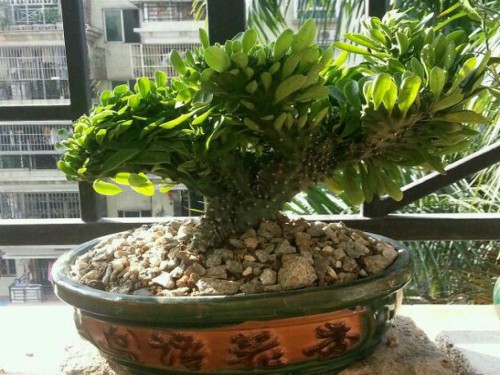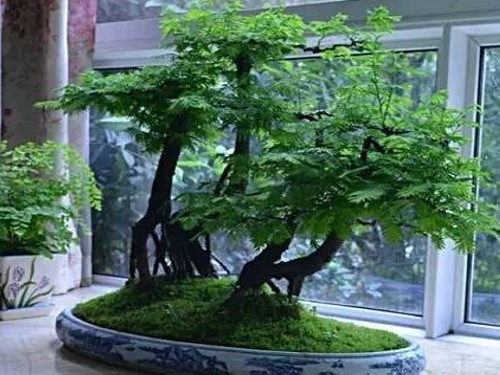How to raise cloud bamboo bonsai
Phyllostachys pubescens is one of the family flower potted plants that many flower friends like very much, so the breeding methods and family maintenance and management methods of Phyllostachys pubescens are also topics that flower friends like to talk about. Next, I would like to introduce the culture method of cloud bamboo for you. Since the cloud bamboo is so good, how can it be cultivated to add to the scenery? First of all, let's take a look at its habits.
In order to raise Phyllostachys pubescens well, it is also very important to be familiar with its growth habits. Phyllostachys pubescens is native to southern Africa. Like warm, moist, semi-overcast environment. Not resistant to cold and drought. Like fertile, loose, well-drained sandy loam. Phyllostachys pubescens likes shade and is mostly used for indoor desk furnishings. Phyllostachys pubescens likes dampness, is afraid of drought, avoids excessive wetness and waterlogging, and has relatively strict requirements for soil and moisture. Mastering appropriate basin soil moisture is a key to the daily maintenance of Phyllostachys pubescens.

1. Basin soil
Phyllostachys pubescens is suitable for growing in warm and humid soil rich in rotten branches and good drainage. Phyllostachys pubescens is afraid of smoke and dust, and if it encounters poisonous gases, its branches and leaves are easy to turn yellow. For this reason, attention should be paid to putting it in a clean environment during maintenance. Phyllostachys pubescens should be fertile soil, if there is no soil change for a long time, nutrients are in short supply, there will be branches and leaves yellowing phenomenon. At this time, it is necessary to pour mature thin liquid fertilizer or compound chemical fertilizer once a week, and water and loosen the soil in time, so that it can change from yellow to green soon. If the fertilizer is too thick or unmature fertilizer is applied, it is easy to cause "watering the root", resulting in the drying and shedding of the leaves. At this time, it is necessary to pour the pot to remove the fertilizer, irrigate the soil block with clean water, and then change it into the new culture soil.
Phyllostachys pubescens is generally suitable for potted plants, because the potted soil can ensure good drainage and good corrosion. And the soil should be clean, otherwise it will be harmed. The soil should be moist, and the soil should be loosened in time to ensure the circulation of air.
2. Lighting
Phyllostachys pubescens is a semi-shady plant, so it is not suitable to bask in the sun for a long time, especially in summer. Spring and summer can be properly exposed to the sun. The cultivation of Phyllostachys pubescens should not be exposed to the hot sun, and it should be placed in a shady and ventilated place in the hot summer and autumn season. The flowering period is afraid of both wind and rain. At this time, we should pay attention to good ventilation, otherwise the fallen flowers will not bear fruit. When potted, it is suitable to put the potted plant outside to receive sunlight on a sunny day, which is beneficial to its light and function.
3. Temperature
Potted Phyllostachys pubescens should be kept at an ambient temperature of more than 5 ℃ in winter to avoid freezing. Phyllostachys pubescens can grow normally as long as the temperature is above 10 degrees Celsius in daily life. In summer, it is put in a ventilated and cool place and properly watered to cool down. In winter, it is necessary to keep the indoor temperature above 5 degrees Celsius. Otherwise, the flowers make the bamboo frostbite and die.
4. Watering
Cloud bamboo for water requirements are not strict, the general standard of watering is that the soil is dry and then watered, watering thoroughly, even the leaves should be watered, but be careful not to cause stagnant water, the air is generally humid in spring and autumn, so it needs to be watered according to the standard, and the soil is easy to dry in summer, so it is appropriate to wet the leaves.
If the potted Phyllostachys pubescens is watered too much, the soil is too sticky and the drainage is poor, it will make the leaves of Phyllostachys pubescens become scorched yellow and fall off, which will affect the growth life. Generally need to wait for the basin soil to see dry before watering, spring and autumn season should reduce watering, adhere to do not water, winter control watering. Excessive watering can easily cause root rot and leaf yellow shedding when the basin soil is too wet. When watering, we should pay attention to the water temperature should be as close as possible to the surrounding temperature, so as to reduce the stimulation of water temperature discomfort to the root system. Spray the leaves with water when the weather is hot and dry.
5. Fertilization
In fact, Yunzhu is not so fond of fertilizer, unlike green pineapple, tiger tail orchid, etc., like rich trees, it can be applied light fertilizer, generally based on nitrogen fertilizer, usually fertilized once a month, otherwise because the potted soil is relatively less, and nutrients can not be replenished in time and appear morbid.
Although Phyllostachys pubescens is not a good fertilizer plant, it can not be short of fertilizer. Potted Phyllostachys pubescens is limited by potted soil, so it is necessary to supplement nutrients in time to meet its growth requirements. The fertilization of Phyllostachys pubescens should be thin and diligent, and do not apply thick fertilizer, otherwise it is easy to cause branches and leaves to turn yellow. The growing season in spring and summer is dominated by nitrogen fertilizer. The mature thin liquid fertilizer can be applied once a month. When the plant is stereotyped, fertilization should be properly controlled to avoid excessive growth and affect the beauty of the plant type.
6. Environmental selection
Cloud bamboo is relatively delicate, it can be said that it is clean, so if you put it in a place with a lot of smoke or smoke, it will make its leaves yellow and dry.
In addition to the above maintenance methods, we should also pay attention to the following points for attention:
1. The soil of Phyllostachys pubescens needs to be treated relatively clean, and adding soil during conservation can not add some dirty things. Changing soil and fertilizing regularly is a good guarantee for the growth of Phyllostachys pubescens.
2. Yunzhu watering should adhere to a principle: no dry, no watering, less watering in spring and autumn, more watering in summer and no watering in winter. Phyllostachys pubescens likes to be slightly moist rather than wet and cannot be watered frequently, but spraying is different. It is foggy water, and it is easy to volatilize, increasing leaf surface humidity and environmental humidity. Spray once in the morning and evening in summer, once a day in spring and autumn, and once every 3-4 days in winter. Except for the rainy season, Phyllostachys pubescens should be sprayed with water frequently in other seasons to keep the environment humid. it is easy to turn yellow if the leaves are too dry.
3. When watering the fertilizer of Phyllostachys pubescens, we should pay attention to the application of thin fertilizer and more fertilizer, the proper fertilizer is the best, and the nitrogen fertilizer is the best. Especially after the plant is fixed, the fertilizer should be properly controlled so as not to cause overgrowth.
4. Yunzhu likes scattered light, and it is best to bask through the window or be sheltered by something, and the indoor light is bright and can be maintained very well. In the light at the same time, remember that the cloud bamboo is semi-shady, not suitable for long-term exposure, as long as it is not taken out in summer.
5. Phyllostachys pubescens will blossom, and it is not suitable for blowing when it blossoms, so the flowering period will be very short, and it will not be suitable for Lin Yu. It will also shorten the flowering period, and it will not bear fruit. When potted, it should be maintained during flowering.
6. in general, if the flowers planted with seeds are used, the sowing season is about April, it can grow normally within 3 years, it can split in the fourth year, and it can blossom and bear fruit in the fourth year.
7. The winter temperature must be above 5 degrees, otherwise it is easy to get frostbite, and the frostbite can not be recovered. If there is not enough temperature for a period of time, then you can use the method of bagging, the bag needs to be supported by a bracket, do not touch the plant directly, and poke several more holes in the bag.
Time: 2019-06-01 Click:
- Prev

How to raise the bonsai of Jade Kylin
Jade Kylin likes warmth and requires plenty of sunshine, which is suitable for sandy loam with good drainage. Drought-resistant, not cold-resistant, but resistant to half-shade, suitable for family potted ornamental. It has green and beautiful leaves, fleshy stems and leaves, and elegant plant shape, which is very similar to the unicorn in ancient Chinese legend, so it is named Jade Kylin.
- Next

How to maintain Metasequoia bonsai
Metasequoia glyptostroboides trunk straight and straight, magnificent tree shape, green leaves, golden leaves after autumn, is a famous courtyard ornamental tree. Metasequoia glyptostroboides can be isolated, arranged or group planted in parks, courtyards, lawns and green spaces. It can also be planted to create scenic forests and adapt to evergreen cover plants; it can also be planted in front of buildings or used as street trees.
Related
- Fuxing push coffee new agricultural production and marketing class: lack of small-scale processing plants
- Jujube rice field leisure farm deep ploughing Yilan for five years to create a space for organic food and play
- Nongyu Farm-A trial of organic papaya for brave women with advanced technology
- Four points for attention in the prevention and control of diseases and insect pests of edible fungi
- How to add nutrient solution to Edible Fungi
- Is there any good way to control edible fungus mites?
- Open Inoculation Technology of Edible Fungi
- Is there any clever way to use fertilizer for edible fungus in winter?
- What agents are used to kill the pathogens of edible fungi in the mushroom shed?
- Rapid drying of Edible Fungi

